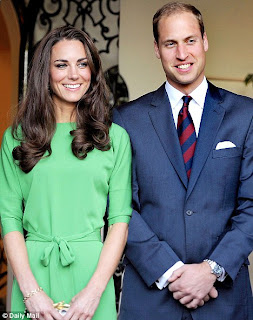 |
| The late Princess of Wales was popularly but incorrectly called Princess Diana. |
So how do we properly address these royal consorts?
Royal Consorts Married to Blood Royals
with Substantive Titles
Substantive title is a title of
nobility or royalty that an individual holds which he either acquires
by grant or by inheritance. Usually, heirs apparent are known for
their substantive titles, as with the case of Prince Charles, who is
known for his substantive title Prince of Wales, and Infante Felipe of Spain, the Prince of Asturias.
 |
| The British press loves to call the Duchess of Cambridge "Duchess Kate,"or worse, only "Kate." |
The British monarchy also assigns
substantive titles to the younger sons of the sovereign, which are
usually inherited by their elder sons.
The younger sons of Queen Elizabeth
also hold substantive titles. Prince Andrew is the Duke of York,
while Prince Edward is the Earl of Wessex. The same is applied to the
queen's male-line cousins. Prince Edward, being the elder son of
Prince George, inherited the title Duke of Kent. Meanwhile, Prince
Richard, as the sole surviving son, assumed his father Prince Henry's
title, as the Duke of Gloucester.
Now, let us go to the titles of their
wives.
The late Princess of Wales was born
Lady Diana Spencer, daughter of the 8th Earl Spencer. Because she was not born a royal, she
was not entitled to carry the title “Princess” before her name.
Thus, calling her “Princess” Diana is technically incorrect, although she is popular referred as such. The
rightful reference to her should be Diana, Princess of Wales, or the
Princess of Wales.
 |
| The Countess of Wessex is sometimes called "Countess" Sophie Wessex. |
In 1996, the Prince and Princess of
Wales divorced but Diana was allowed to continue using her title,
although her style as Royal Highness ceased, since she was no longer a member
of the British Royal Family. She died in 1997. In 2006, the Prince of Wales married Camilla Parker-Bowles.
Technically, she should have assumed the title
Princess of Wales since she is the wife of the prince, but to avoid
confusion and in respect to Diana, who still enjoyed the love and
admiration of the Britons, she assumed her husband's second
title, which is Duchess of Cornwall. In Scotland, she is referred
as the Duchess of Rothesay, because the prince's official Scottish
title is the Duke of Rothesay.
Moving forward to Prince William's
wife, Catherine Middleton officially assumed the title Duchess of
Cambridge upon her marriage to Prince William, who was proclaimed Duke of Cambridge. As such, she should be officially
referred to as HRH the Duchess
of Cambridge, not as “Duchess” Catherine, as what most British
tabloids call her. Her complete title and style is Her Royal Highness Princess William, Duchess of Cambridge, Countess of Strathearn,
Baroness Carrickfergus.
 |
| The Baroness Marie-Christine Von Reibnitz is popularly known as Princess Michael of Kent after she wedded Prince Michael, a royal prince who doesn't hold a substantive title. |
The same is true with Sophie, Countess
of Wessex. She isn't “Countess” Sophie Wessex, but the Countess
of Wessex, her complete title and style being The Princess Edward,
Countess of Wessex, Viscountess Severn.
Royal Consorts of Princes with
Territorial Suffix By Virtue of their Parent's Title
Prince Harry (official known as Prince
Henry of Wales), Princesses Beatrice and Eugenie of York, Prince
Michael of Kent, and Princess Alexandra of Kent fall under this
category. These blood royals are usually younger sons or the
daughters of a royal prince who happens to be the younger sons of
sovereign who carries a substantive title. Prince Harry uses the
territorial suffix “of Wales” since Prince Charles being
the Prince of Wales. The same is true with Princesses Beatrice and
Eugenie, daughters of the Duke of York, and the Queen's cousins,
Prince Michael and Princess Alexandra of Kent, the younger son and
the daughter of King George V's youngest son, Prince George, Duke of
Kent.
In the case that bride weds a royal
prince with territorial suffix, she assumes her husband's name and
title. This is the case of Baroness Marie-Christine von Reibnitz who
is popularly known as Princess Michael of Kent, after her wedding
to Prince Michael.

.png)





5 Comments
"Catherine, Duchess of Cambridge" would only apply if she were divorced from the Duke. She should currently be called only the "Duchess of Cambridge." Think.... "Sarah, Duchess of York" or "Diana, Princess of Wales." The first name is only used by a divorcee and only as long as she does not remarry.
ReplyDeleteVery true!
ReplyDeletevery important documents!!!
ReplyDeleteSo much incorrect information in this article.
ReplyDelete-There is no such title as 'Crown Prince' in Spain. Before becoming King, Felipe was 'The Infante Felipe, Prince of Asturias'.
-As already commented, Catherine is only 'HRH The Duchess of Cambridge'. Putting her name before that indicates she is a divorcee.
-And she is not "the" Princess William (that article is only used for children of the sovereign).
-The Countess of Wessex IS "the" Princess Edward, etc., as her husband is the son of the sovereign.
-Princess Alexandra hasn't been "of Kent" since she married in 1963. (Princesses cease using territorial designations upon marriage.) She is HRH Princess Alexandra, The Hon. Lady Ogilvy.
-Marie-Christine is not "the" Princess Michael of Kent. Her husband is not the child of a sovereign.
We have made the necessary corrections. Thank you.
Delete